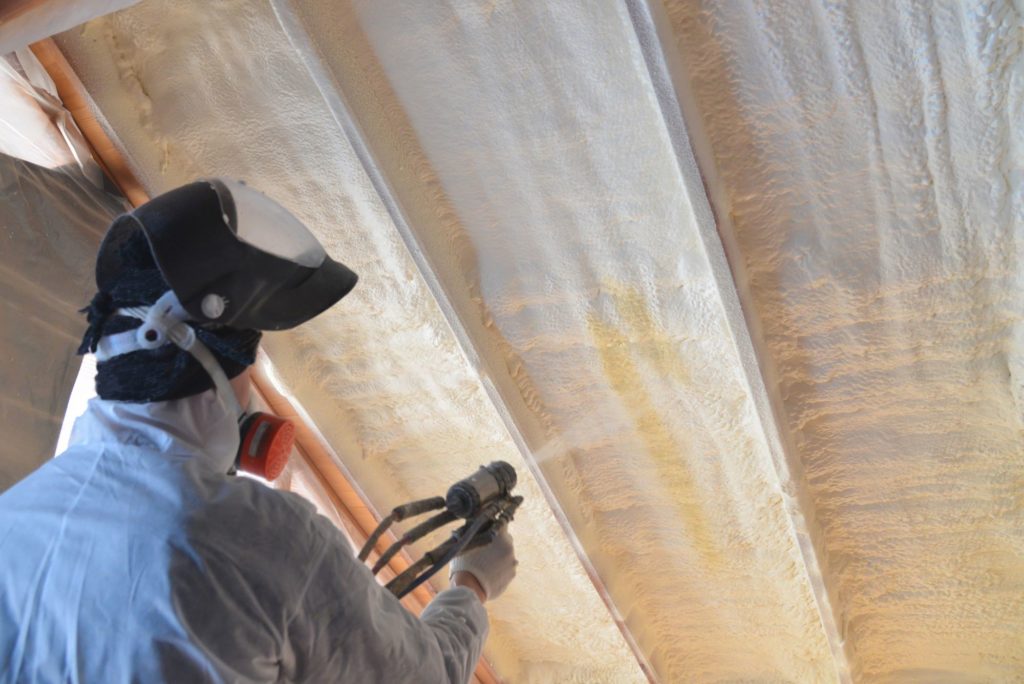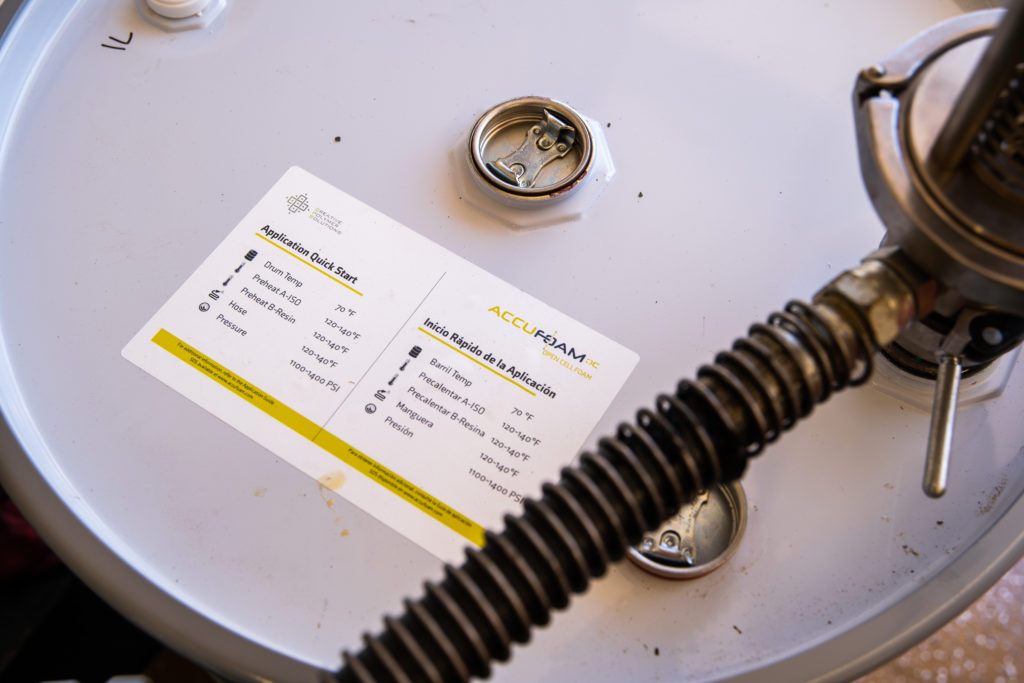
While there are challenges that come with the application of spray foam insulation during colder months, there are always tips and tricks that professionals can keep in mind when working on projects.
Keep reading to find out our tips for applying spray foam insulation in cold weather!
Temperature and Moisture Considerations
Cold weather spray foam installation requires preparation and consideration to make sure you get the job done effectively.
It’s very important to know the seasonal formulation required for the ambient and substrate temperatures you are working with.
Product Storage Temperature
Specific products will have optimal temperature ranges that are precise and unique to their chemical makeup. However, it’s good to know the overall temperature range that spray foam insulation products should be kept at.
The temperatures of spray foam drums in storage should hover between 60°-90°F, depending on the product. Once again, this is a general recommendation. Always check your product’s technical data sheet for specific information.
Keeping your spray foam stored in the correct temperatures gives you better results when you arrive at the job site. When your spray foam is kept within the appropriate temperature range, you’ll achieve optimal coverage per gallon, faster project start times, higher yield, and an overall better spraying experience with fewer hiccups!
We’ll discuss the ways you can keep your product drums at an ideal temperature below.
Ambient Air Temperature
Ambient air temperature is the temperature of the air inside the space you’re applying spray foam insulation to.
Spray foam insulation can be applied in all sorts of ambient air temperatures since its chemical makeup can be tailored by batch. However, the overall range that these different formulas can perform well in lies between 20°-95+°F.
We’ll tell you more about how you can regulate your space’s ambient air temperature safely and effectively below.
Substrate Temperature and Moisture Content
Substrate temperature refers to the temperature of the surface you are spraying, such as plywood, metal, etc.
As with ambient air temperatures, spray foam insulation should be installed on substrates with a temperature range of 20°-95+°F.
We’ll give you tips on maintaining optimal substrate temperatures below.
The moisture level of all construction substrates should not exceed 19% for all Accufoam products. A simple moisture meter can be used to help you determine what the conditions are like on your surfaces.
General Tips for Installation in Cold Weather
One way to successfully apply spray foam insulation in the winter despite the unideal conditions is to use a winter blend of spray foam. Companies such as Accufoam® provide custom formulations that are specifically designed to work within defined temperature ranges.
Accufoam®’s closed cell spray foam can perform well in the following ambient air temperature ranges, thanks to different chemical formulas. These winter formulas are:
- Polar Grade
- Winter Grade
- Regular
- Summer Grade
- Summer+ Grade
However, open cell spray foams cannot be customized to this degree. In that case, you need to make sure your storage, ambient air, and substrate temperatures are all kept in appropriate ranges. Here are some tips on how to do that!
Tips to Keep Your Spray Foam Drums at the Optimal Temperature in Storage:

- Pay attention to the temperature of your storage facility, your rig, and your project setup. Make sure there are thermometers in all of these spaces.
- To monitor the temperature of the product inside your drums, use a laser thermometer.
- Create separation between your drums and the floor of your storage facility, truck, or project setup. To do this, place the drums on their wooden pallets.
- Utilize heaters within your storage facility, rig, or project setup according to safety best practices.
Accufoam®’s open cell spray foam can actually be heated up in the drums using other spray foam insulation equipment during cold weather and while mixing.
The proportioner, if equipped with circulation lines, can be used to warm up the drums (not to exceed 90°F) by circulating through the machine back into the drums. The machine heaters should be set no higher than 110°F during this operation. Once again, this should ONLY be carried out with open cell insulation; closed cell foams should not be recirculated.
Now that we’ve covered some tips about keeping your drums warm, let’s learn about how to keep your ambient air and substrate temperatures in an optimal range!
Tips for Keeping Your Ambient Air and Substrate Temperature Optimal in the Winter
Keeping your ambient air and substrate temperatures in a good range is simple, but you need to be cautious about how you do it.
Here’s the simple part: you can use indoor heating and portable heaters to warm up the installation space and keep it within the optimal temperature range.
However, it is absolutely crucial to make sure the heaters get turned off prior to spraying. If the fumes from spraying interact with the heating machinery, they can put off toxic fumes and damage other equipment.
Essentially, you just need to pay attention to indoor heating best practices. Always refer to your product’s safety and technical data sheets for specific information.
To make sure that your spray foam cures as well as it was sprayed, heat should be maintained in the building for at least 24 hours after spraying.
The Accufoam® Difference
As we mentioned, Accufoam® provides different temperature grade formulas for our closed cell spray foams, so you can know that your product will perform exactly how you need it to while you’re working.
Plus, our open cell product is so reliable that you’ll be able to ensure success with some simple workspace temperature regulation.
Accufoam® makes spray foam insulation that’s rigorously tested in real job site conditions, so you’ll be able to spray with confidence knowing that it performs in the real world, not just the lab.
Further, our products are backed by fanatical quality control and dedicated customer service. We’ll empower you to be the source that clients look to when they need dependable results that will keep their buildings safe, dry, comfortable, and energy-efficient.
If you’re interested in learning more about spray foam insulation in cold weather, be sure to read our blog on the benefits of winter spray foam installation.
Contact us today, and we’ll connect you with a professional installer in your area. Call (205) 440-4996 or fill out our online contact form to get started.


